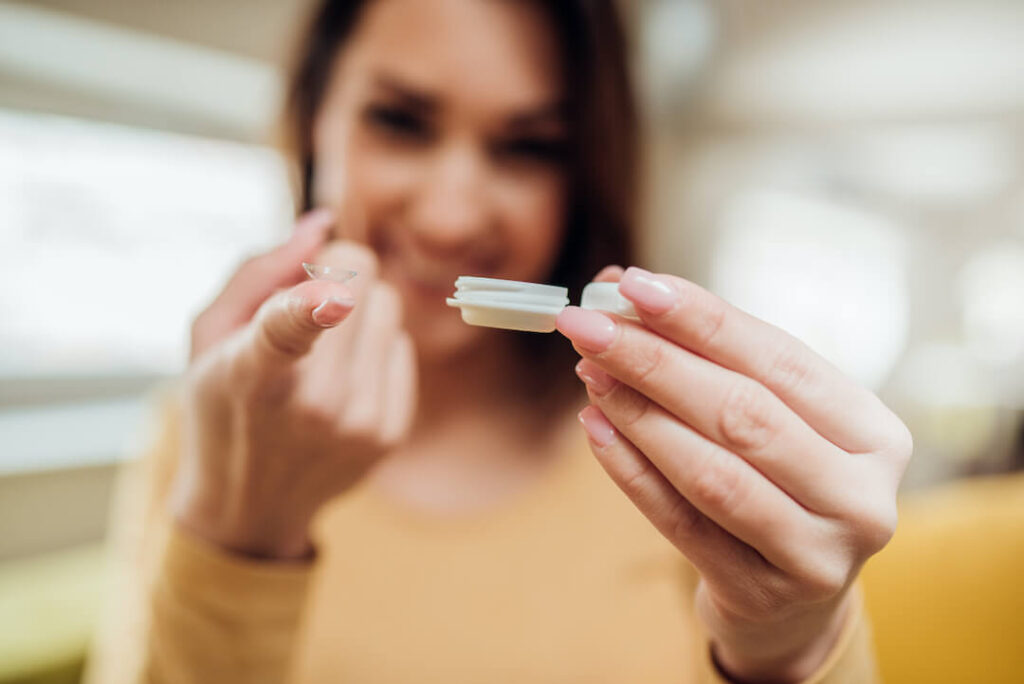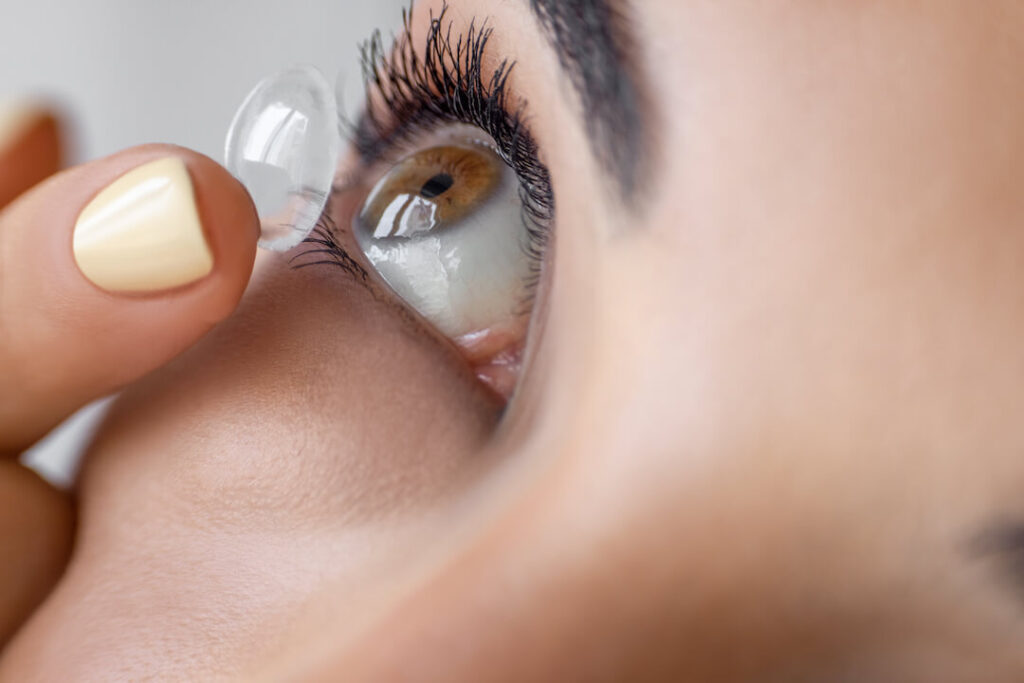If you are having trouble wearing contact lenses, follow Linneo’s guide for contact lenses for dry eyes
You know the feeling when you put your contacts in, and they just don’t feel right. For some contacts wearers, the feeling takes longer to appear. Sometimes, feelings of dryness take hours of wear to set in. Whether your eyes are too dry to get your lenses in properly or you can only wear them for a few hours, the experts at Linneo can help.
You’re not alone. Countless people feel this irritation daily. However, there is hope we can make a change.
We’re going to explore several different types of contact lenses today and how they affect dry eyes. Then, we’ll discover various types of contact lenses tailored for dry eyes and practical tips on lens care and hygiene. We’ll dive into how silicone hydrogel lenses or scleral lenses could change your life.
Are you ready for better daily comfort and relief from dry eye symptoms, keep reading!
Table of Contents
Understanding Dry Eyes and Contact Lenses
In order to find the best contact lenses for dry eyes, we need to understand the different causes

Dry eye syndrome can throw a wrench into the comfort and effectiveness of wearing contact lenses. This condition occurs when your eyes don’t produce enough quality tears, leading to dryness, itchiness, or even blurred vision.
The Impact of Dry Eye Syndrome on Contact Lens Wear
If you’re experiencing red eyes, sensitivity to light, or feeling like there’s dust in your eyes, it could be due to dry eye syndrome. Wearing traditional contact lenses may worsen these symptoms because they absorb moisture from the tear film covering our eyeballs.
In fact, people with this issue often struggle with standard soft contacts since they reduce natural lubrication and exacerbate discomfort. Moreover, if you’ve ever felt fatigued after long hours of lens wear—that too might be a sign.
But not all hope is lost for those who need corrective eyewear but suffer from dry eyes. The key lies in choosing the best contacts and the right contact lenses for dry eyes.
You see—different types of contacts are designed to combat various issues associated with specific eye conditions. For instance, silicone hydrogel contact lenses have high water content to help keep your peepers moisturized throughout the day. There is also the option for daily disposable contacts that can eliminate some dry eye symptoms as well.
If frequent replacement seems daunting, then daily disposable lenses offer an excellent alternative as they decrease protein build-up, which causes irritation & further reduces hydration levels in already parched ocular surfaces.
Choosing the Right Contact Lens Type for Dry Eyes
If your eyes feel like a desert, don't fret. We're going over some of the best contact lenses for dry eyes
Silicone hydrogel lenses are superheroes in disguise. They allow more oxygen to flow to your eyes, which helps reduce irritation. These soft contact lenses have high water content and can absorb moisture from the air around you. That’s great news if you’re dealing with dry eye symptoms.
Daily contacts, made of silicone hydrogel, may help ease those itchy, red feelings. Their special design lets them retain more moisture than standard soft contact lenses.
Daily disposable lenses offer another advantage—they decrease protein build-up on the lens surface, which can irritate eyes over time and cause dryness or blurred vision.
And here’s something surprising—did you know that even if your tears evaporate quickly, causing dryness, certain types of contacts can still keep your eyes hydrated? Yep. Some scleral lenses, also known as gas permeable (GP) ones, sit on the white part of your eye without touching the cornea and create a tear reservoir between themselves and the eye surface, providing continuous hydration.
When it comes to contact lenses for dry eyes, there are two factors you need to consider:
- Oxygen Flow: Silicone hydrogel allows more oxygen flow, reducing irritation
- Lens Moisture: Daily disposable lenses can decrease protein build-up and reduce dryness
Depending on the cause of your dry eyes, you may find one option that works better than the other. By consulting with a professional, you can feel more confident in your decis
The Role of Scleral Lenses in Managing Dry Eyes
In your quest to find the best contact lenses for dry eyes, you should understand how scleral lenses work

If you’re grappling with severe dry eye conditions, scleral lenses could be a game-changer. Unlike standard soft contact lenses that sit on the cornea, these large custom-fit contacts rest on the sclera—your eye’s white outer layer.
How Scleral Lenses Treat Dry Eye
Specially designed to vault over the entire corneal surface and rest on the ‘white’ of your eyes (the sclera), they create a tear-filled reservoir between the back surface of the lens and your cornea. This helps keep those peepers moist.
Apart from providing moisture, another perk is their potential to promote healing for inflamed or damaged surfaces of your eyes due to chronic dryness. By reducing friction against sensitive tissues when blinking, it lets you say goodbye to irritation while boosting comfort levels.
These wonder lenses might need more cleaning than others because they tend to attract mucus production more readily.
Don’t let this deter you. Yes, there’s some extra care involved, but remember—we’re talking about an improved vision experience here. Users report lessening dry eye symptoms thanks largely to scleral creating that fluid barrier that aids healing as well as lubrication.
Practical Tips for Wearing Contact Lenses with Dry Eyes
Part of betting the best contact lenses for dry eyes is taking proper care of them
If you wear contacts and suffer from dry eyes, proper lens care is crucial. First off, always wash your hands before handling lenses. This prevents dirt or oils from getting on the lenses and irritates your sensitive eyes further.
Proper cleaning of contact lenses can also make a big difference in comfort. Clean them each time they’re removed using a recommended lens solution to get rid of protein build-up that could cause discomfort.
Daily disposable lenses might be a good option, too—these cut down on deposits and allergens from daily lenses since you toss them at day’s end.
Beyond just cleaning routines, it’s important to follow wear schedules set by your eye doctor strictly—don’t overwear your lenses if you already have dry eyes. Your eyes need breaks and extended wear to produce quality tears necessary for keeping dryness at bay. To avoid increasing dryness, follow these tips.
- Do not sleep in contacts
- Avoid wearing contacts while swimming or showering
- Take frequent screen breaks if working long hours digitally, as blue light exposure can exacerbate dryness symptoms
Lubricating eye drops are another game-changer when dealing with this condition—these artificial tears provide instant relief whenever needed during the day, but remember not all drops are safe for use with contacts, so double-check before purchase.
Lifestyle Adjustments to Manage Dry Eyes While Wearing Contact Lenses
Managing dry eyes while wearing contact lenses can be a real challenge, but some lifestyle adjustments might just do the trick

In addition to finding the best contact lenses for dry eyes, there are some other steps you can take to improve your comfort when wearing contacts.
Nutrition and Hydration
Taking note of your nourishment is the initial move. Consuming omega-3 fatty acids found in fish like salmon or supplements may help improve tear quality. Staying well-hydrated by drinking plenty of water also helps keep your eyes moisturized.
Environment Matters
Your environment plays a significant role, too. Try using humidifiers at home or work if you’re experiencing dry eye symptoms because they can add moisture back into the air. Research suggests that avoiding smoky, windy, or very cold conditions could reduce symptoms as these environments tend to cause tears to evaporate more quickly.
Contact Lens Choices
Making smart choices about your contacts matters as well. Daily disposable lenses are often better for those with dry eyes as they minimize protein buildup, which leads to irritation and increased dryness over time.
Eyes Need Rest
Last but not least, remember that even your eyes need rest. Extensive exposure to blue light from screens can lead to hormones in our bodies that regulate sleep cycles off track, causing our body clocks to go haywire, resulting in the worsening of dry eye syndrome—so take regular breaks from screen time. So, don’t let dry eyes get in the way of your contact lens wear. With these lifestyle adjustments, you can reduce symptoms and enjoy clear vision with less discomfort.
Special Considerations for Contact Lens Wearers with Dry Eyes
Try any of these methods to help with symptoms of dry eyes

If you’re experiencing dry eyes, wearing your contacts for dry eyes can be a real pain. You may feel irritation and dryness due to the lens affecting tear evaporation or blocking oxygen from reaching your eyes.
But don’t worry. There are options that cater specifically to your needs. Gas-permeable lenses, for instance, could be a great fit. These let more oxygen pass through to the eye compared to standard soft contact lenses. As they retain their shape while allowing tears underneath them, these can give you clearer vision while reducing discomfort.
Hormonal changes also play an important role in managing dry eye symptoms when wearing contacts. Certain stages of life, like menopause, might increase instances of dry eyes because hormonal imbalances affect tear production.
Making small adjustments such as taking regular breaks from screen time (remember, blue light exposure dries up your eyes), staying hydrated, and following a balanced diet rich in omega-3 fatty acids helps, too.
Maintaining eye health and quality of life is essential for those suffering from Dry Eye Syndrome. So keep experimenting until you find what works best for you because clear vision shouldn’t come at the cost of comfort.
FAQs About Contact Lenses for Dry Eyes
Which contact lenses are good for dry eyes?
Silicone hydrogel lenses, daily disposable contacts, and scleral lenses can be solid picks for folks with dry eyes.
Are monthly or daily contacts better for dry eyes?
Daily disposables might have the edge because they lessen protein build-up and reduce irritation. Plus, there’s no need to clean them.
How do you keep your eyes hydrated when wearing contacts?
Maintain proper lens hygiene, stick to wear schedules, use lubricating eye drops, and make lifestyle tweaks monthly lenses like upping water intake.
You’ve learned that the various types of contact lenses available differ in terms of their effectiveness at relieving dry eyes. The world of contact lenses for dry eyes has opened up with options like silicone hydrogel and daily disposable best contact lenses for dry eyes.
Scleral lenses emerged as game-changers, providing comfort and moisture while promoting healing. Proper lens care became paramount in managing dry eye symptoms – remember those lubricating drops!
Lifestyle adjustments, too, play a part—hydration, nutrition, and blue light exposure; they all count. You now know how hormonal changes or medical conditions can impact your experience wearing contacts.
Dry-eyed but enlightened! That’s the takeaway here: being aware of these choices puts power back into your hands (or rather on your eyeballs). Remember to consult an eye doctor before making any decisions about what type of contact lens is best for you.

